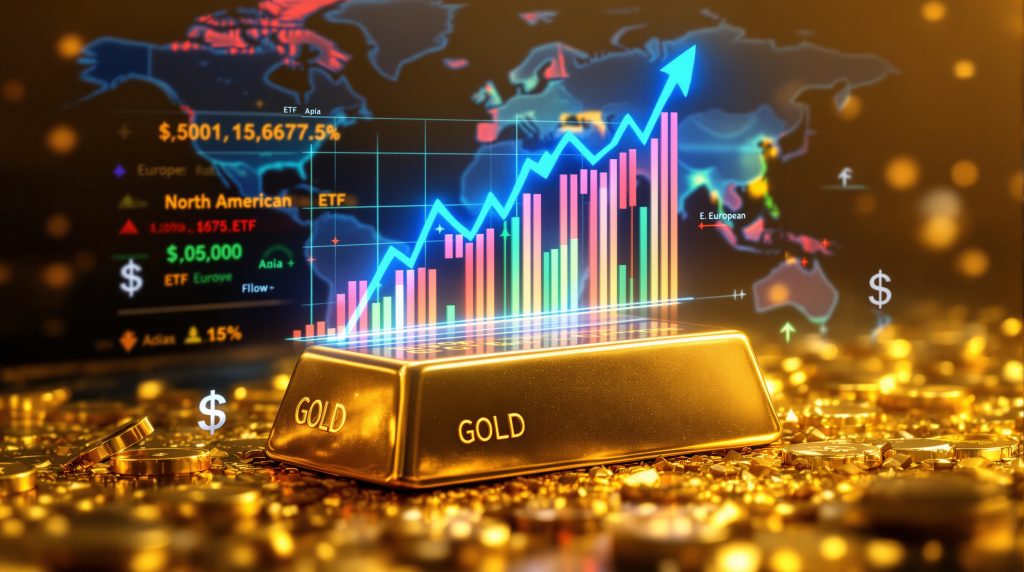Understanding the Gold ETF Revolution
Gold Exchange-Traded Funds (ETFs) represent a revolutionary financial instrument allowing investors to gain exposure to gold without physically owning the precious metal. These investment vehicles typically purchase and store physical gold bullion, with each share representing ownership of a fraction of an ounce of gold. The structure creates a direct link between ETF activity and physical gold demand, establishing a mechanism through which investor sentiment can influence the impact of ETF investments on gold prices.
Since the launch of the first gold ETF in Australia in 2003, followed by SPDR Gold Shares (GLD) in the United States in 2004, these instruments have transformed the accessibility of gold investments. The market has expanded from a niche product to a mainstream investment vehicle with global gold ETF holdings standing at approximately 3,195 tonnes valued at $263 billion as of December 2024, according to the World Gold Council. In addition, recent gold prices analysis indicates a strong correlation between ETF flows and market movements.
What Are Gold ETFs and How Do They Work?
Gold ETFs operate through a creation and redemption mechanism managed by Authorized Participants (APs)—typically large financial institutions. When investors purchase ETF shares, APs deliver physical gold to the fund's custodian in exchange for newly created ETF shares. Conversely, when investors sell shares, APs redeem these shares for physical gold from the fund's reserves.
This direct connection to physical gold means that significant ETF buying or selling translates to actual movement in physical gold, unlike futures contracts which may never result in physical delivery. Most major gold ETFs maintain allocated physical gold holdings stored in secure vaults, with regular audits verifying these holdings.
The Evolution of Gold ETF Markets
The growth of gold ETFs has been remarkable since their inception. North American gold ETFs currently dominate the market, holding approximately 1,627 tonnes as of December 2024, representing roughly 51% of global gold ETF holdings. European-listed funds follow closely with approximately 1,268 tonnes.
The COVID-19 pandemic marked a watershed moment for gold ETFs, with global inflows reaching a record 877 tonnes in 2020, coinciding with gold reaching an all-time high of $2,067.15 per ounce in August of that year. This demonstrated the powerful relationship between ETF flows and price action during periods of economic uncertainty. Furthermore, the historic gold surge witnessed in 2025 was significantly influenced by ETF investment patterns.
The Direct Price Impact Mechanism
The mechanism by which ETF investments influence gold prices is both direct and measurable. Research consistently shows a strong correlation between significant ETF flows and gold price movements, though the relationship isn't perfectly linear and varies based on market conditions.
How ETF Inflows Drive Gold Price Movements
When investors purchase shares in gold ETFs, the creation process requires fund managers to acquire additional physical gold. This creates real-time demand in the wholesale gold market, particularly during periods of strong inflow. These purchases typically occur in the London Over-The-Counter (OTC) market or through COMEX futures, with physical settlement occurring within 2-3 business days.
The World Gold Council's research has identified that substantial ETF inflows often correlate with upward price movements, especially when inflows occur rapidly during periods of market uncertainty. This relationship forms one of the most direct and observable links between investor sentiment and gold prices in modern markets, as confirmed by JPMorgan's commodity research.
Quantifying the ETF-Price Relationship
Statistical analysis demonstrates a positive correlation between gold ETF flows and price movements. Research by Oxford Economics for the World Gold Council found that gold ETF flows have a statistically significant relationship with gold prices, with the correlation varying by time period and market conditions.
While specific elasticity measurements vary across studies, the relationship is particularly pronounced during periods of market stress when investors seek safe-haven assets. This relationship isn't perfectly linear—other factors including central bank buying, jewelry demand, and macroeconomic conditions also influence prices concurrently.
The Amplification Effect During Market Stress
During periods of economic uncertainty or market volatility, the ETF-price relationship often strengthens. The 2020 pandemic provides a clear example—as global markets plummeted in February and March, gold ETFs saw massive inflows as investors sought safe havens, helping push gold prices higher despite broader market turmoil.
This pattern underscores how ETFs can amplify existing price trends during stress periods. Interestingly, during the most acute phase of the March 2020 market disruption, gold ETFs briefly experienced outflows of 116 tonnes globally as investors liquidated even safe-haven assets to raise cash, demonstrating the complex dynamics at play during extreme market conditions.
Regional ETF Flow Dynamics
The impact of ETF flows on gold prices varies significantly by region, with distinct patterns emerging across major markets. These regional differences create nuanced effects on gold price formation and market liquidity.
North American vs. European ETF Influence
North American and European gold ETFs together account for over 80% of global gold ETF holdings, giving them outsized influence on global gold prices. However, their influence patterns differ significantly.
North American ETF investors tend to exhibit more tactical behavior with shorter holding periods. These funds experienced more volatile flows during 2020-2024, creating more pronounced short-term price impacts. Using December 2024 data and approximate gold prices of $2,600/oz, North American holdings (1,627 tonnes) were valued at approximately $136 billion.
European gold ETF investors typically demonstrate more strategic positioning with longer holding periods. This creates more stable, sustained price support even during periods of market volatility. As of December 2024, European holdings (1,268 tonnes) were valued at approximately $106 billion.
Emerging Market ETF Growth
Chinese and Indian gold ETF markets have grown substantially in recent years, introducing new dynamics to gold price formation. Chinese gold ETF holdings reached 73 tonnes by the end of 2024, showing significant growth from negligible levels just a few years prior.
India's gold ETF assets under management reached approximately $2.3 billion as of March 2024, according to the Association of Mutual Funds in India. This growth reflects broader financial market development in these traditionally strong physical gold consumer markets.
The expansion of Asian ETF markets has increased the importance of Asian trading hours in global gold price discovery, creating a more continuous 24-hour price formation process. As these markets continue to mature, their influence on global gold prices is expected to grow proportionately.
ETFs vs. Other Gold Market Drivers
While ETFs significantly influence gold prices, they represent just one component of a complex market ecosystem that includes several major demand sources.
Relative Impact: ETFs, Central Banks, and Physical Demand
Each demand segment affects gold prices through different mechanisms and timeframes:
ETF Investments: Highly visible with rapid transmission to prices. ETF flows are transparent and reported regularly, making their impact easily observable in short-term price movements.
Central Bank Purchases: Less transparent but substantial long-term price support. Central banks purchased 1,045 tonnes of gold in 2024, marking the second-highest year of purchases since 1950. This followed record purchases of 1,082 tonnes in 2022 and 1,037 tonnes in 2023.
Jewelry Demand: Slower-moving but provides baseline support. Global jewelry consumption totaled 2,092 tonnes in 2024, according to the World Gold Council, representing the largest single category of gold demand by volume.
Technology/Industrial Usage: Minimal price impact relative to investment flows. Technology sector gold demand was 328 tonnes in 2024, providing steady baseline demand but with less sensitivity to price movements.
The total above-ground stock of gold is estimated at approximately 212,582 tonnes as of 2023, valued at approximately $13.7 trillion at $2,000/oz. This massive existing stock means that even large annual flows represent a relatively small percentage of the total market.
Interest Rates and Currency Effects vs. ETF Flows
The relationship between gold prices and ETF flows must be considered alongside macroeconomic factors. Multiple academic studies have found that interest rate expectations and currency valuations (particularly the US dollar) remain dominant drivers over longer timeframes.
Gold tends to perform well when real interest rates (nominal rates minus inflation) are low or negative. This relationship is often more powerful than ETF flows in determining long-term price trends. When the US dollar weakens, gold typically strengthens as it becomes less expensive in other currencies, stimulating demand independent of ETF activity. The complex relationship between gold and broader financial markets is further explored in the comprehensive gold-stock market guide.
The Liquidity Paradox
Gold ETFs have fundamentally altered the liquidity profile of gold as an asset class, creating both benefits and potential risks for market participants.
How ETFs Enhance Market Liquidity
Gold ETFs have dramatically increased the liquidity of gold as an asset class. The SPDR Gold Shares (GLD) regularly trades over 5-10 million shares daily, representing approximately $1.3-2.6 billion in daily liquidity based on share prices around $260.
Major gold ETFs like GLD typically maintain bid-ask spreads of 1-2 basis points during normal market conditions, comparable to highly liquid equity securities. This enhanced liquidity has attracted institutional investors who previously avoided gold due to market access limitations.
The creation/redemption mechanism ensures that ETF prices remain closely aligned with underlying gold prices, providing efficient price discovery and allowing large positions to be established or unwound without the logistical challenges of physical gold transactions.
When ETF Liquidity Creates Volatility
Despite generally improving market liquidity, during extreme market conditions, ETF trading can paradoxically increase volatility. During the March 2020 market disruption, gold ETFs experienced net outflows of 116 tonnes globally despite gold's safe-haven status, as investors sold liquid assets to raise cash during the pandemic crisis.
This phenomenon occurs because ETFs represent one of the most liquid ways to gain gold exposure. When investors face margin calls or urgent liquidity needs, they may sell their most liquid assets first—including gold ETFs—even if they remain bullish on gold's long-term prospects. This can temporarily accelerate price declines as physical gold is sold to facilitate ETF redemptions.
The liquidity paradox underscores why ETF flows must be interpreted carefully during extreme market events, as they may reflect broader market liquidity dynamics rather than fundamental views on gold.
Investment Implications
The transformation of gold markets through ETFs has significant implications for portfolio construction, risk management, and investment strategy implementation.
Portfolio Diversification Effects
Gold ETFs have made portfolio diversification more accessible to a broader range of investors. Research by Oxford Economics for the World Gold Council found that a 2-10% allocation to gold optimized risk-adjusted returns for USD-based portfolios over the long term.
Academic research has consistently shown gold's correlation with equities is typically low to negative, with correlation to the S&P 500 averaging around -0.01 to 0.1 over long periods. This makes gold a particularly effective diversifier during equity market downturns.
The incorporation of gold through ETFs allows for more precise allocation adjustments and rebalancing compared to physical gold, enhancing overall portfolio efficiency. This accessibility has expanded gold's role in mainstream portfolio construction beyond traditional allocation models.
ETFs vs. Physical Gold: Performance Differences
While gold ETFs closely track spot prices, they aren't perfect substitutes for physical gold ownership. Several key differences affect total returns and risk profiles:
Tracking Accuracy: ETFs typically experience small tracking errors (0.1-0.4% annually) due to management fees and operational costs.
Cost Structure: ETFs charge annual expense ratios ranging from 0.17% (Aberdeen Standard Physical Gold Shares ETF) to 0.40% (SPDR Gold Shares), while physical gold typically involves one-time premiums of 2-8% over spot plus potential storage costs.
Liquidity: ETFs offer high liquidity during market hours, while physical gold liquidity depends on dealer relationships and can vary significantly.
Counterparty Risk: ETFs involve some counterparty risk through the custodial arrangement, while direct physical possession minimizes this risk but introduces security concerns.
Tax Treatment: In many jurisdictions, ETFs and physical gold receive different tax treatments, potentially affecting after-tax returns.
Future Trends in ETF-Price Dynamics
The evolving gold ETF landscape continues to introduce new influences on price formation and market structure. The gold market surge in 2025 demonstrates how these instruments continue to evolve and influence the broader market.
Digital Gold and Tokenization Effects
Blockchain-based gold tokens have emerged as competitors to traditional ETFs, including products like PAX Gold (PAXG) and Tether Gold (XAUT). While their combined market capitalization remains minimal compared to traditional ETFs, they represent an innovation with potential long-term implications.
These digital alternatives may further enhance gold market liquidity and price discovery while potentially reducing the dominance of conventional ETFs in setting market direction. They offer potential benefits including 24/7 trading, fractional ownership, and reduced minimum investment sizes.
As blockchain technology matures and regulatory frameworks develop, these products may capture increasing market share, particularly among younger investors and those in regions with less developed traditional financial infrastructure.
ESG Considerations and Price Premiums
Environmental, Social, and Governance (ESG) factors are increasingly influencing gold ETF design. The London Bullion Market Association (LBMA) launched its Responsible Gold Guidance in 2012 and updated it in 2017 and 2021, setting standards for responsible sourcing that many ETF providers now follow.
Several ETF providers have introduced products that exclusively source gold from mines with superior environmental practices or conflict-free certification. This trend parallels broader ESG integration across asset classes and responds to growing investor demand for sustainable investment options.
While comprehensive data on potential price premiums for ESG-focused gold products remains limited, the development of tiered pricing based on sustainability credentials represents an important evolution in gold market structure that may influence future price formation.
What Investors Should Watch
For investors seeking to understand or anticipate gold price movements, monitoring ETF flows provides valuable signals, though these must be interpreted alongside other market indicators.
Key ETF Flow Indicators for Price Prediction
Investors monitoring gold price trends should track several ETF-specific indicators:
Weekly flow data from major ETF providers: Major gold ETF providers typically report daily holdings changes, with aggregated data available from sources like the World Gold Council.
Changes in total gold holdings across all ETFs: Comprehensive data showing the total gold backing all ETFs globally provides a broader picture than focusing on individual products.
Divergences between regional ETF flows: Differences between North American, European, and Asian flows can provide early signals of changing market sentiment or regional economic concerns.
Unusual options activity in gold ETF markets: Options trading patterns on major gold ETFs can reveal sophisticated investors' positioning and expectations.
Data sources for monitoring these indicators include individual ETF provider websites (for daily holdings updates), the World Gold Council's Gold Demand Trends (monthly/quarterly), and CFTC's Commitment of Traders reports for futures positioning (weekly). Understanding these indicators can help investors make informed decisions based on the latest gold price forecast.
When ETF Flows May Mislead
While ETF flows provide valuable signals, they can occasionally mislead investors. Several scenarios warrant caution in interpretation:
Central bank activity: When central banks are active buyers but operate discreetly, ETF outflows might suggest bearish sentiment while prices remain supported by this "invisible" demand.
OTC market positioning: Large institutional investors may use over-the-counter methods to establish gold positions without utilizing ETFs, creating disconnects between visible flows and price action.
Liquidity-driven selling: During broad market stress, ETF outflows may reflect liquidity needs rather than negative views on gold fundamentals.
Seasonal patterns: Certain seasonal patterns in ETF flows may reflect tax considerations or portfolio rebalancing rather than changing sentiment toward gold.
FAQ: Gold ETFs and Price Impact
Do Gold ETFs Actually Own Physical Gold?
Most major gold ETFs maintain allocated physical gold holdings stored in secure vaults, with regular audits verifying these holdings. For example, SPDR Gold Shares (GLD) publishes daily bar lists showing specific serial numbers of gold bars held in custody.
Each share typically represents ownership of a fraction of an ounce of gold, creating a direct link between ETF shares and physical metal that transmits investor demand to the physical market. The physical gold is stored in specialized vaults, primarily in London, with independent audits conducted regularly by accounting firms.
Some smaller ETFs may use alternative structures, including unallocated gold accounts or derivative-based approaches, which can affect how directly they influence physical gold markets.
Can ETF Trading Cause Gold Price Manipulation?
While ETF trading can influence short-term price movements, the size and depth of the global gold market (estimated at over $13.7 trillion including all forms) make sustained price manipulation through ETFs difficult.
Regulatory oversight of ETF operations, including the creation/redemption process and physical gold custody, provides safeguards against market abuse. The transparency of ETF holdings, with daily published reports, also reduces the potential for undetected manipulation.
However, large institutional flows into or out of ETFs can temporarily accelerate price trends in either direction, creating short-term volatility that may appear disruptive to market participants with longer time horizons.
How Quickly Do ETF Flows Impact Gold Prices?
The transmission mechanism from ETF flows to gold prices typically operates with minimal lag in modern markets. The creation/redemption process directly connects ETF share issuance with physical gold purchases, creating a near-immediate impact on wholesale gold markets.
In practice, the price impact develops over several trading sessions as physical gold is purchased or sold by fund managers and as market participants interpret the significance of the flows. The speed of transmission has accelerated over time as market efficiency has improved and information dissemination has become more rapid.
The magnitude of price impact depends on flow size, market conditions, and whether the flows confirm or contradict existing market narratives about gold's prospects.
The Evolving ETF-Price Relationship
Gold ETFs have fundamentally transformed how capital flows into and out of the gold market, creating more direct transmission mechanisms between investor sentiment and gold prices. While they remain just one factor in a complex market ecosystem that includes central banks, jewelry demand, mining output, and macroeconomic conditions, their influence has grown substantially.
The relationship between ETF flows and gold prices continues to evolve as markets mature and new products emerge. The growing influence of Asian ETF markets, the development of ESG-focused products, and the emergence of blockchain-based alternatives all point to further evolution in how investor capital impacts gold prices.
For investors, understanding this relationship provides valuable insights for portfolio management. ETF flows offer a transparent window into investor sentiment and physical gold demand that wasn't available before these products existed.
As financial markets and technologies continue to develop, the gold ETF landscape will likely become more diverse and sophisticated, potentially enhancing market efficiency while creating new dynamics in price formation.
Disclaimer: This article contains forward-looking statements based on current expectations and market conditions. Such statements involve risks and uncertainties, and actual results may differ materially from those projected. Investors should conduct their own research and consult with investment professionals before making investment decisions regarding gold or gold-related products.
Ready to Stay Ahead of the Next Major Gold Discovery?
Gain instant alerts on significant ASX mineral discoveries through Discovery Alert's proprietary Discovery IQ model, turning complex gold data into actionable investment insights. Understand why historic discoveries can generate substantial returns by visiting Discovery Alert's dedicated discoveries page and begin your 30-day free trial today to position yourself ahead of the market.




